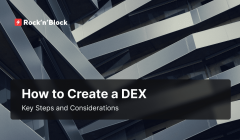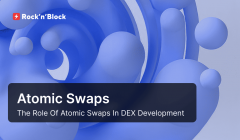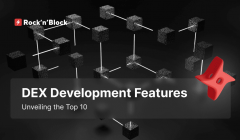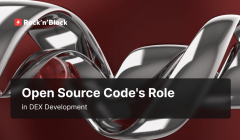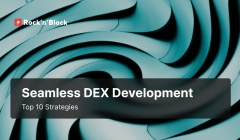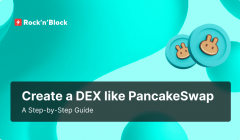9 Tips on How to Create a DEX that Stands Out
03 May 2024Decentralized Exchange Development has become a signature of financial innovation in the constantly evolving landscape of decentralized finance. As the demand for secure, autonomous, and user-centric trading platforms intensifies, the challenge lies not just in entering the decentralized exchange space but in creating a DEX that truly stands out amidst a myriad of offerings. This article examines the multifaceted journey of Decentralized Exchange Development, including strategic considerations, innovative features, and adherence to robust development practices.
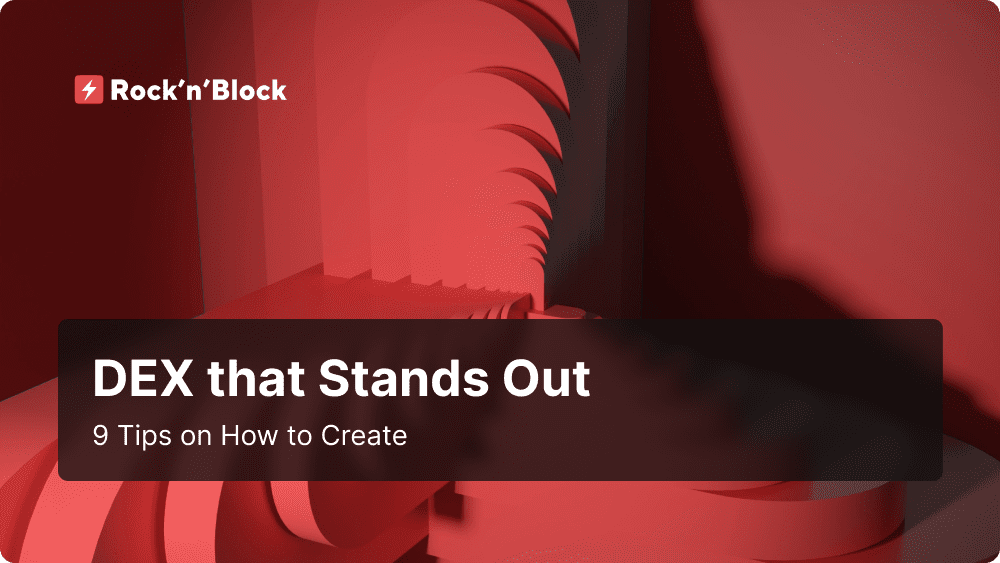
Table of Contents:
-
Decentralized Exchange Overview
-
Understanding the DEX Landscape
-
Tips to Create a DEX That Will Stand Out
-
Tip 1: Start DEX Development with a Market Research
-
Tip 2: Analyze Competitors’ DEX Platforms
-
Tip 3: Design Your Unique DEX
-
Tip 4: Put Security Measures First
-
Tip 5: Implement Gamification Strategies
-
Tip 6: Create Personalized User Dashboards
-
Tip 7: Provide Social Trading Features
-
Tip 8: Implement User-Created Pools and Tokens
-
Tip 9: Adhere to Established DEX Development Practices
-
Conclusion
Decentralized Exchange Overview
Decentralized exchanges are a fundamental part of the blockchain and cryptocurrency world, embodying the principles of decentralization and trustless trading. Unlike traditional centralized exchanges, DEXs operate without a central authority, allowing users to trade directly from their wallets and maintain control over their private keys. Decentralized Exchange Development fosters transparency, security, and censorship resistance within the cryptocurrency trading ecosystem.
The recently expired 2023 year marked a positive trajectory for the category, with a consistent increase in value driven by market dynamics. In particular, DEXs have achieved a remarkable trading volume of $835 billion last year, underscoring their growing acceptance among traders. Expected to revolutionize the financial landscape, Decentralized Exchange Development is poised to unveil its distinctive characteristics in 2024.
As well as technical challenges in Decentralized Exchange Development, DEXs have faced increasing competitive pressure in this volatile market environment. In 2023, there were more than 160 DEXs competing in the market. Uniswap continued to dominate the DEX market in terms of volume, accounting for 55.7% of the total volume traded on the platform last year. However, the competitive nature of this market presents challenges even to well-established players. For example, in January 2024 the Cosmos-based v4 version of dYdX had just seen $757 million in volume over a 24-hour period, beating Uniswap v3 which had $608 million, the data shows.
To create a DEX that excels, developers and entrepreneurs must take a multifaceted approach that includes user-centric design, technological innovation, community engagement, strategic market positioning, and unique features and approaches. By addressing these aspects, they can develop a DEX that competes in the current landscape and defines the future of decentralized finance.
Understanding the DEX Landscape
The DeFi space has seen a surge in DEX platforms, each competing for user attention and market dominance. To create a DEX that stands out, developers and entrepreneurs must delve into the intricate nuances of the DEX landscape.
Trends in Decentralized Exchange Development
The decentralized exchange landscape is a dynamic ecosystem that has undergone significant evolution, reflecting the rapid growth and adoption of DeFi platforms. Currently, numerous DEXs contribute to the decentralized trading infrastructure, each bringing unique features and functionalities to the table. The most common ones found in most successful DEXs are listed below.
-
User Experience
Leading DEXs are currently steering towards a user-centric approach, specifically targeting the non-crypto native audience. A pivotal trend involves prioritizing seamless user experiences (UX/UI) to simplify the often complex world of cryptocurrency trading. DEXs are implementing educational initiatives to bridge the knowledge gap, offering resources to empower users with a deeper understanding of decentralized finance.
The integration of account abstraction, exemplified by standards like ERC-4337, is gaining prominence. This development abstracts away the need for users to hold multiple tokens for gas fees, enhancing accessibility and convenience in Decentralized Exchange Development.
-
Scaling solutions
DEXs are increasingly adopting Layer 2 solutions to address scalability challenges on the Ethereum blockchain, enhancing transaction throughput while mitigating congestion and high gas fees. The integration of zero-knowledge protocols, known for their privacy and efficiency, is also gaining increasing adoption among Decentralized Exchange Developers.
-
Concentrated liquidity
Uniswap V3 introduced concentrated liquidity, setting a new trend in Decentralized Exchange Development and allowing providers to strategically allocate assets within specific price ranges for increased capital efficiency and precise management in decentralized exchanges.
-
Uniswap V4 Features
Launching in 2024, Uniswap V4 will bring substantial enhancements to dDecentralized Exchange Development. Notable features include "hooks" for customizable smart contract functionalities, a Singleton contract for efficiency, consolidating pools and reducing gas costs, and a "flash accounting" system facilitating multiple actions in a single transaction, enhancing transaction efficiency and security while significantly lowering gas costs.
-
Derivatives
Derivatives in DEXs refer to financial instruments like options, futures, and perpetual swaps that derive their value from underlying assets. In Decentralized Exchange Development, these derivatives enable users to engage in advanced trading strategies, including leveraged positions and risk management, offering a broader range of financial instruments and functionalities within the DeFi ecosystem.
-
Interoperability and Cross-Chain Trading
Some DEX platforms are pushing the boundaries of interoperability, allowing users to trade assets across different blockchain networks. This trend of cross-chain trading reflects a commitment to expanding liquidity and providing users with seamless access to a wide range of digital assets.
-
Advanced Security Measures
Security is paramount in the world of cryptocurrency. Successful DEXs implement robust security measures, including end-to-end encryption and secure key management systems. Building and maintaining user trust requires an unwavering commitment to the highest security standards.
-
Decentralized Governance Models
The inclusion of decentralized governance mechanisms allows users to actively participate in the decision-making processes of Decentralized Exchange Development. Voting on protocol upgrades, fee structures, and other critical decisions fosters a sense of community ownership.
-
Innovative Liquidity Strategies
To create a successful DEXs it's important to go beyond basic liquidity provision by implementing innovative strategies. This includes incentivizing liquidity providers through yield farming, liquidity mining, and other reward mechanisms, thereby ensuring a vibrant and liquid marketplace.
Tips to Create a DEX That Will Stand Out
In the competitive landscape of DEXes, it's important to recognise that with a well-defined strategy and solid Decentralized Exchange Development approach, you can not only create a DEX platform, but also capture the attention of the large user base. In the upcoming sections, we will explore key considerations and strategies that can enable you to bring your decentralized vision to life.
🔎 Tip 1: Start DEX Development with a Market Research
Market research and analysis play a pivotal role in Decentralized Exchange Development that not only meets the current needs of users but also anticipates future trends and challenges.
The cryptocurrency market is known for its volatility, with trends and preferences shifting rapidly. Conducting in-depth market research allows DEX creators to stay ahead of the curve, identifying emerging trends, and understanding the evolving preferences of traders and investors.
Define Your Target Audience
To create a DEX, the first step is to research and define your audience. Understanding their preferences and needs in the DeFi space informs a user-centric design, ensuring your Decentralized Exchange Development roadmap aligns seamlessly with their requirements for optimal adoption and engagement.
User-Centric Design
Creating a standout DEX requires a deep understanding of user preferences. Market research helps in identifying features and functionalities that resonate with users, allowing for the development of a user-centric design. Intuitive interfaces, personalized dashboards, and responsive customer support are elements that stem from understanding user preferences.
Niche Market Integration
Identifying niche markets or underserved segments within the cryptocurrency space provides an opportunity to create a DEX that stands out. Market research helps in recognizing specific asset classes or trading pairs that may be in demand but are not adequately addressed by existing platforms.
Global Regulatory Considerations
Regulatory landscapes vary globally, impacting user preferences and the overall demand for decentralized exchanges. Market research helps DEX creators navigate and understand the nuances of regulatory environments, ensuring that the Decentralized Exchange Development aligns with legal requirements in various jurisdictions.
Innovation in Tokenomics
Understanding fundamentals and trends in tokenomics is crucial for creating a DEX with a unique value proposition. Researching and implementing innovative token utilities and reward mechanisms can attract and retain users, fostering an engaged and active user base.
👀 Tip 2: Analyze Competitors’ DEX Platforms
Analyzing competitors plays a pivotal role in the strategic DEX software development that stands out in the highly competitive landscape of DeFi. Understanding the strengths and weaknesses of existing platforms provides invaluable insights for crafting a distinctive offering when looking to create a DEX.
Benchmarking Against Industry Leaders
Analyzing successful DEX platforms provides valuable insight into industry standards and best practices. Understanding what works well for market leaders and identifying areas for improvement enables strategic decisions to be made in the outstanding DEX development.
For example, explore our guide on Top 5 Decentralized Exchanges on Ethereum!
Competitor Feature Analysis
A thorough analysis of competitors’ features helps in identifying gaps and opportunities. By recognizing areas where other DEXs excel or fall short, creators can tailor their platform to offer unique functionalities, ensuring differentiation in a crowded market.
Community Feedback and Sentiment
Monitoring community feedback and sentiment on existing DEX platforms provides valuable insights. Understanding what users like or dislike about competitors helps refine the vision for Decentralized Exchange Development and address pain points that may have been overlooked.
Technological Advancements
Competitor analysis extends beyond user features to the underlying technology. Understanding the technological choices and innovations adopted by other DEXs aids in making informed decisions about their technical architecture. By being aware of the landscape of technological advancements in the industry, you position yourself to not only meet, but exceed the expectations of your competitors, fostering a platform that stands out in both functionality and technical prowess.
Explore the features and underlying technologies of leading platforms and learn how to create a DEX like them:
Strategic Positioning
Analyzing competitors allows you to define your strategic positioning in the market. Whether through differentiation in asset support, user experience, or governance models, understanding the competitive landscape is crucial for defining a unique selling proposition of Decentralized Exchange Development.
⚡️ Tip 3: Design Your Unique UX/UI for your DEX
To create a DEX that not only competes but stands out in this dynamic environment, strategic design considerations are paramount. This section delves into the key elements of designing your unique DEX, emphasizing User Experience and User Interface (UX/UI), innovative features and functionality, as well as security measures and compliance.
User Experience and User Interface
Creating a DEX that resonates with users starts with a well-designed user interface and experience. The UX/UI design should prioritize intuitive navigation, ensuring that users can seamlessly explore the platform. Implementing customizable interfaces allows users to personalize their trading environment, enhancing overall user experience. A visually appealing and user-friendly design not only attracts traders, but also contributes to increased engagement and loyalty. The DEX you create should strive for an interface that is both aesthetically pleasing and functionally efficient.
Innovative Features and Functionality
Innovation is the cornerstone of a standout Decentralized Exchange Development. To create a DEX that captures attention, consider integrating unique and innovative features. Think beyond traditional trading paradigms and explore functionalities that set your DEX apart, ensuring a differentiated and compelling offering in the competitive DeFi landscape.
🔐 Tip 4: Put Security Measures First
Create a DEX that adheres to best security practices of decentralized exchange development, ensuring a robust and secure platform.
Smart Contract and Security Audits
Smart contract audits are essential to create a secure DEX, identifying and addressing vulnerabilities. Prioritizing regular audits enhances code integrity, instilling user confidence through collaboration with auditing firms.
Testing and Static Analysis Solutions
Integrating testing procedures and leveraging static analysis tools in DEX software development is crucial for bug detection. New tools, including static analysis, syntactic analysis, exploit analysis, and formal verification, are emerging, drawing from extensive industry experience.
Secure Token Approvals
To create a DEX, secure token approvals are crucial for minimizing risks. Users should seek approval for specific amounts rather than granting access to the entire token quantity. This approach enhances security, mitigating potential threats associated with unauthorized access during interactions with smart contracts.
Continuous Monitoring and Incident Response
Continuous monitoring and proactive incident response are vital for secure Decentralized Exchange Development. Real-time monitoring detects anomalies and security threats promptly, while robust incident response plans ensure effective action in case of breaches, minimizing overall impact.
Using a Decentralized Oracle Network
Employing a Decentralized Oracle Network for exchange rate valuation enhances accuracy compared to centralized oracles. Collecting prices from various sources, weighting by volume, and eliminating outliers provide a decentralized and reliable view of global exchange rates, strengthening the security and transparency of DeFi exchanges.
Creating a Disaster Recovery Plan
A disaster recovery plan is crucial for DEX security, especially during unforeseen events like hacks. Consider decentralized insurance protocols for financial security without compromising decentralization. Careful upgrade plans and emergency 'pause' features enhance cybersecurity response and protocol longevity.
Preventing Common Glitches
In Solidity-based contract development, understanding DeFi security concepts is vital. Awareness of potential vulnerabilities, such as overflows/underflows, gas limit issues, avoiding tx.origin use, proxy storage collision, and ensuring accuracy in token transfer calculations, is essential for creating robust and secure contracts.
🎮 Tip 5: Implement Gamification Strategies
Adopting innovative gamification strategies can be a game-changer in Decentralized Exchange Development. By infusing elements of play to earn into the trading experience, DEXs can not only attract but also retain a more engaged user base. This section explores the significance of gamification in Decentralized Exchange Development, with a focus on token rewards, yield farming games, and community challenges.
Explore Trends in P2E Projects Development!
Token Rewards and Incentives
-
Yield Farming
Yield farming development has become a cornerstone of decentralized finance, enabling users to earn rewards by providing liquidity to various protocols. Incorporating yield farming into the Decentralized Exchange Development adds a layer of gamification, transforming the act of staking and providing liquidity into an interactive and rewarding game.
-
Dynamic Reward Structures
Designing dynamic reward structures, where users can earn additional tokens based on liquidity pool contribution, enables to create a DEX with an engaging environment. This not only fosters increased participation but also keeps users excited about the potential for diverse token rewards.
-
Seasonal Yield Farming Events
Running seasonal or thematic yield events adds a time-sensitive and competitive element. This fosters a sense of urgency and community participation as users compete for higher rewards.
Community Challenges and Competitions
-
Interactive Challenges
Beyond traditional trading, introducing interactive challenges related to market prediction, portfolio management, or specific asset performance creates a sense of competition and camaraderie among users. These challenges can be designed as periodic events, encouraging ongoing engagement.
-
Incentivized Leaderboards
Implementing leaderboards that showcase the performance of users in various challenges provides a visible recognition of achievements. Incentivizing these leaderboards with unique rewards, badges, or even limited-edition NFTs encourages healthy competition and community participation.
-
Collaborative Competitions
Facilitating collaborative competitions, where users work together to achieve specific goals, promotes a sense of community and shared success. This approach will help to create a DEX that not only enhances user engagement but also strengthens the community bonds.
-
Quest to Earn
Quest to Earn campaigns for DEXs introduces engaging challenges, encouraging users to embark on an exciting journey within the platform. This gamification feature not only promotes community collaboration and healthy competition but also rewards participants with incentives, enhancing user engagement and loyalty.
-
Trading Competitions
Trading competitions are events that bring a sense of excitement to the trading ecosystem. They challenge users to showcase their trading skills within a specific timeframe, promoting healthy competition.
👥 Tip 6: Create Personalized User Dashboards
This section explores the importance of personalized user dashboards in the journey to create a DEX that not only attracts users but keeps them engaged and satisfied.
Customizable Interfaces
The ability to create a DEX with customizable interfaces significantly enhances the overall user experience. Traders can optimize their workspace to access critical information swiftly, fostering efficiency and reducing the learning curve associated with navigating complex interfaces.
-
Widget-Based Dashboards
When aiming to create a DEX that resonates with users, customizable interfaces stand out as a key feature in Decentralized Exchange Development. Widget-based dashboards empower users to tailor their trading environment according to their preferences. Widgets, small modular components, can be rearranged and personalized, providing users with the flexibility to prioritize the information that matters most to them.
The ability to add, remove, or resize widgets enhances the user experience by putting control directly into the hands of traders. This dynamic and interactive approach transforms the trading dashboard from a static interface into a personalized workspace.
-
Adaptive User Profiles
Adaptive user profiles take personalization to the next level by allowing users to create and switch between profiles based on their trading strategies or preferences. Traders may have different strategies for various market conditions, and adaptive profiles enable them to seamlessly transition between tailored setups.
This feature caters to both novice and experienced traders. Newbies can start with predefined profiles to simplify their experience, while advanced users can create intricate setups to align with their specific trading strategies. Adaptive user profiles create a sense of ownership and individuality within the DEX platform development.
The Impact on User Engagement and Loyalty
-
Increased Time-on-Platform
Customized interfaces contribute to increased user retention as traders are more likely to spend extended periods on a platform that aligns with their preferences. The dynamic and engaging nature of personalized dashboards keeps users actively involved, translating to a longer time-on-platform metric.
-
Community Building
The ability to create a DEX with personalized dashboards fosters a sense of community among users. Traders can share and exchange widget configurations, strategies, and adaptive profiles, creating a collaborative environment where knowledge and insights are shared among the community.
💭 Tip 7: Provide Social Trading Features
This section delves into the significance of social trading and explores how features such as mirror trading, copy trading strategies, and social sentiment analysis can elevate Decentralized Exchange Development to new heights.
Mirror Trading
-
Copy Trading Strategies
The concept of copy trading revolutionizes the way users engage with decentralized finance. When aiming to create a DEX that stands out, integrating copy trading strategies enables users to replicate the trades of successful and experienced investors automatically.
By offering users the ability to browse through a selection of top-performing traders, evaluate their strategies, and opt to mirror their trades, a DEX can democratize trading expertise. This Decentralized Exchange Development Feature provides a bridge between seasoned traders and those who are less experienced, fostering a collaborative and supportive trading environment.
-
Social Sentiment Analysis
Social sentiment analysis involves analyzing social media and community discussions to determine market moods. Adding this feature into Decentralized Exchange Development enables users to stay informed about the broader market sentiment, empowering them to make more informed trading decisions.
A DEX provides real-time sentiment indicators and trend analyses, allowing users to align their trading strategies with prevailing market sentiments. Social sentiment analysis promotes community intelligence, where users contribute to a shared understanding of market dynamics.
The Impact on User Engagement and Trading Success
-
Community Collaboration
Social trading features encourage community collaboration, transforming trading from an isolated activity to a communal endeavor. Users can share insights, discuss market trends, and collectively adapt to changing conditions, fostering a sense of camaraderie within the DEX platform.
-
Risk Mitigation
Copy trading strategies, when implemented thoughtfully, enable users to mitigate risks by diversifying their portfolios. Instead of relying solely on personal insights, users can spread their investments across multiple successful traders, reducing the impact of individual losses on their overall portfolio.
🧩 Tip 8: Implement User-Created Pools and Tokens
In the world of Decentralized Exchange Development, empowering users and fostering community engagement is a key attribute of innovation. This section explores the potential of user-created pools and tokens, emphasizing the importance of community-driven liquidity pools, user-created token listings, and governance mechanisms for user-created assets in the quest to create a DEX that stands out.
Community-Driven Liquidity Pools
-
User-Created Token Listings
Elevating the user experience in a Decentralized Exchange Development involves going beyond the standard listings of well-known tokens. A standout DEX allows users to actively participate in shaping the available assets by enabling user-created token listings. This feature empowers token creators, projects, and even communities to propose and list their tokens on the platform.
User-created token listings contribute to diversity within the DEX ecosystem, facilitating the inclusion of emerging projects and new token offerings. This inclusivity not only attracts a wider user base but also positions the DEX as a hub for innovation and community-driven growth.
-
Governance Mechanisms for User-Created Assets
The inclusion of governance mechanisms specific to user-created assets is essential for maintaining a balanced and fair ecosystem. Users should have the ability to participate in decision-making processes related to the inclusion, modification, or removal of user-created tokens from the platform.
Implementing decentralized governance models, such as voting mechanisms or stakeholder proposals, ensures that the community can participate in the evolution of your Decentralized Exchange Development. This approach fosters community engagement and establishes a sense of ownership among users.
The Impact on Community Engagement and Platform Viability
-
Inclusive Ecosystem
User-created pools and tokens foster an inclusive ecosystem where a diverse range of projects and communities can actively participate. This inclusivity contributes to a more vibrant and dynamic DEX platform development.
-
Innovative Token Offerings
Allowing users to create and list their tokens promotes innovation within the platform. Emerging projects, experimental tokens, and community-driven initiatives can find a home within the DEX, providing users with unique and novel opportunities for investment.
-
Enhanced Liquidity and Trading Options
Community-driven liquidity pools not only enhance liquidity but also provide users with a broader array of trading options, contributing to a more robust and attractive trading environment, allowing you to create a DEX with a constant flow of assets.
The Importance of Vigilance in User-Created Pools and Tokens
While the advent of user-created pools and tokens undoubtedly brings a new era of inclusivity and innovation to decentralized exchanges, it is imperative for users to exercise due diligence in this dynamic landscape. The cryptocurrency realm has, unfortunately, witnessed instances of scams and fraudulent activities. As a precautionary measure, DEX platforms typically emphasize the importance of users verifying the contract address of any token before making a purchase.
This extra layer of caution ensures that users can navigate the burgeoning variety of tokens with prudence, safeguarding themselves against potential risks. In an environment where creativity and community participation flourish, user awareness and discernment become crucial tools for fostering a secure and trustworthy decentralized ecosystem. As DEXs continue to evolve, this commitment to user education and protection becomes integral to sustaining a flourishing and secure community of traders.
☑️ Tip 9: Adhere to Established DEX Development Practices
To create a DEX, it is essential to adhere to all the rules and techniques of reliable DEX development.
Choosing the right blockchain is fundamental as it determines the platform's scalability, transaction speed, and interoperability. Opting for a blockchain that aligns with the DEX's objectives is crucial for long-term success.
DEX security considerations play a pivotal role in instilling user confidence. Implementing robust security measures, such as multi-signature authentication and thorough security audits, safeguards user assets and protects against potential vulnerabilities.
In this case, we have selected some comprehensive guides for you, covering everything from the fundamentals of DEX development to the step-by-step process of releasing the platform to the mainnet. Please continue reading:
It is essential to realise that in order to create a DEX that stands out, you don't just need to focus on unique features, you also need to develop a solid foundation.
Conclusion
In conclusion, the journey to create a DEX that stands out in the bustling landscape of decentralized finance requires a meticulous blend of innovation, adherence to best practices, and a deep understanding of user needs. The dynamic nature of the DeFi ecosystem necessitates continuous evolution and adaptation, and those who navigate this path with foresight and dedication will not only attract users but also shape the future.
We ❤️ Development
Follow us on social media to receive the hottest blockchain development updates
Twitter ⚡️Telegram⚡️LinkedIn⚡️Facebook
